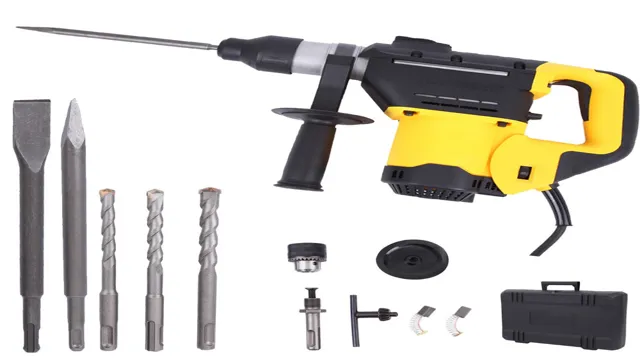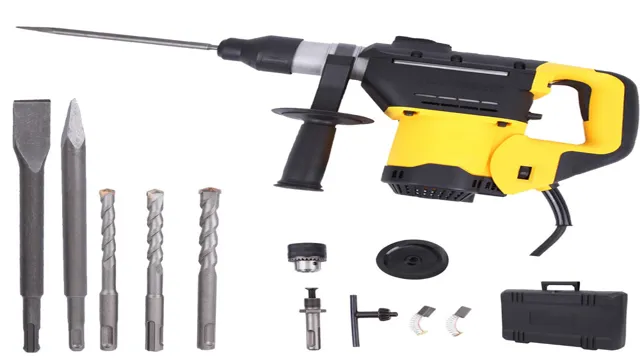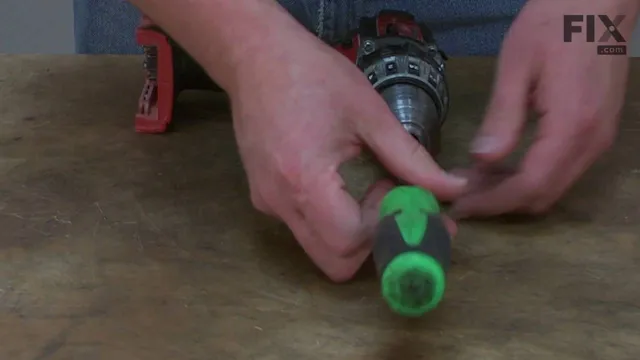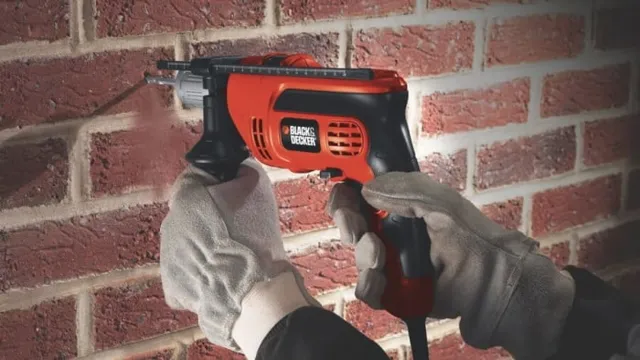Can You Use a Chisel with a Hammer Drill? Find Out How to Chisel Efficiently

Are you thinking of using a chisel with a hammer drill but not sure how it works or if it’s even possible? Don’t worry, you’re not alone. Many people are unfamiliar with this technique and have questions about how to do it correctly. In this blog post, we will explain how to use a chisel with a hammer drill in a step-by-step guide so that you can confidently take on your next DIY project.
We’ll go over the tools you’ll need, the safety precautions you should take, and the process involved in chiseling with a hammer drill. So, grab a cup of coffee and let’s dive in!
Understanding Hammer Drills
When it comes to using a chisel with a hammer drill, it’s not a typical combination. Hammer drills are designed to use rotary motion and percussive force to drill holes in tough materials like concrete and masonry. Chisels, on the other hand, are used to carve or chip away at materials like wood, stone, or metal.
While it may be possible to use a chisel attachment with some hammer drills, not every model will support it. You’ll need to check your manufacturer’s recommendations to see if your hammer drill is compatible with a chisel attachment. Even with a compatible attachment, it’s important to use caution and follow the proper safety procedures to avoid accidents or damage.
Overall, while a hammer drill may be versatile, it’s not always the best choice for every task, and a separate chisel or other specialized tool may be required.
What is a Hammer Drill?
A hammer drill is a power tool that combines a rotating motion with a back-and-forth motion to create a hammering effect. It is typically used for drilling through hard materials such as concrete, masonry, or stone. This tool works by using a special mechanism that allows the motor to slide back and forth while it rotates, causing the drill bit to move up and down rapidly.
With this combination of motions, a hammer drill can easily break through tough materials that a regular drill would struggle with. If you are looking to do some heavy-duty construction or renovation work, a hammer drill could be a useful addition to your toolkit. Just remember to always wear safety gear and take all necessary precautions when using power tools.

How is it different from other drills?
Hammer drills are a kind of power tool designed for drilling holes in hard surfaces like concrete, masonry, and bricks. Unlike traditional drills that simply spin and bore through surfaces, hammer drills have a hammering or pounding motion that breaks up hard materials. This is why hammer drills are also called impact drills.
Unlike regular drills, hammer drills use special bits that are designed to withstand the impact created by the hammering motion. Another significant difference between hammer drills and other drills is that hammer drills come with adjustable speed options, allowing the user to control the speed of the drilling process. These features make hammer drills suitable for heavy-duty jobs and construction work.
With a hammer drill, holes can be drilled into even the most robust surfaces in a fraction of the time it would take with traditional drilling methods. So, whether you are a professional builder or a DIY enthusiast, a hammer drill is a valuable tool to have in your power tool collection.
When should a hammer drill be used?
A hammer drill is a powerful tool designed to bore through tough materials such as concrete, stone, and masonry. When should a hammer drill be used? Well, if you’re working on a construction project that involves drilling into hard surfaces, a hammer drill is a must-have. This is because a regular drill won’t be able to penetrate these surfaces, and using one could result in damage to the tool or injury to the user.
Hammer drills are also useful in DIY projects such as installing shelves or hanging frames on concrete walls. With the help of a hammer drill, you can ensure a secure and long-lasting installation. So next time you’re working on a project that involves drilling into hard surfaces, don’t hesitate to use a hammer drill.
It will save you time and effort in the long run, and ensure precise and safe drilling.
Why Use a Chisel with a Hammer Drill?
If you’re wondering whether you can use a chisel with a hammer drill, the answer is yes! A hammer drill is not only useful for drilling into concrete, but it can also be used for chiseling. Using a chisel alongside a hammer drill can make your job easier and more efficient. The combination of a chisel and hammer drill is ideal for breaking away concrete, plaster, brick, and other tough materials.
It saves you time and effort compared to using a manual chisel and ordinary drill. Plus, hammer drills come with different settings, so you can adjust the power based on the material you are working on. When using the chisel, make sure to free the bit, so it moves freely to avoid overworking the motor.
Overall, using a chisel with a hammer drill is a reliable and versatile technique for any construction or DIY project.
Benefits of using a hammer drill with a chisel
If you want to make your construction tasks faster and more efficient, you might want to use a hammer drill with a chisel. A hammer drill is a powerful tool designed for drilling through concrete, masonry, and other tough surfaces. But with the addition of a chisel, its capabilities expand to include demolition tasks, like removing tiles, breaking up concrete slabs, and more.
By using a chisel with a hammer drill, you can exert more force on the surface you’re working on, making it quicker and easier to break it apart. Plus, the combination of the hammer drill and chisel can reduce operator fatigue, giving you more energy to tackle more demanding jobs. So if you want to take your construction work to the next level, consider adding a chisel to your hammer drill toolbox.
Types of Chisels Compatible with a Hammer Drill
Using a chisel with a hammer drill can produce impressive results when working on concrete or masonry. The reason is simple: chisels have sharp edges that can chip away at concrete and masonry surfaces, making them ideal for breaking or chipping away at stubborn materials. To use a chisel with a hammer drill, you will need to ensure that the chisel can be clamped in the chuck firmly.
The most common types of chisels used with hammer drills are flat chisels, pointed chisels, and tile chisels. Flat chisels have a broad, flat cutting edge and are suitable for chipping or cutting away large chunks of masonry or concrete, while pointed chisels have a pointed tip that is ideal for penetrating the surface of the material before chipping it away. Tile chisels, on the other hand, are designed for removing tiles, and they have a bevelled edge that can help you cut through tile adhesive.
By using the right chisel with your hammer drill, you can save time and effort while achieving professional results.
How to Use a Chisel with a Hammer Drill?
Yes, you can use a chisel with a hammer drill! Many people don’t realize that a hammer drill can be a versatile tool that can serve you in various ways. Chiseling is one of the tasks that a hammer drill can handle. Usually, concrete chisels are used for breaking up concrete surfaces, but you can use other chisels for chiseling wood or other materials besides concrete.
First, you need to insert the chisel into the chuck of the hammer drill and tighten it securely. Then, you can adjust the depth stop on the drill to control the depth of the chiseling. Be sure to wear gloves, safety goggles, and earplugs to protect your hands, eyes, and ears while working.
The chiseling motion is generated by the hammer drill’s hammering action, which is why it’s important to hold the drill steady and keep it perpendicular to the surface you’re chiseling. So whether you need to chip away at concrete, carve out a design on wood, or remove tile, a hammer drill with a chisel attachment can make the job a lot easier!
Step-by-Step Guide for Using a Chisel with a Hammer Drill
Using a chisel with a hammer drill can be an efficient way to carve out precise channels and grooves in tough materials like concrete or stone. To get started, select an appropriate chisel bit and insert it securely into the hammer drill chuck. Next, adjust the depth gauge on the drill to fit the length of the chisel bit.
This is important to prevent over-exertion of the bit and ensure accuracy in the carving process. Once the bit is secure and the depth gauge is set, turn on the hammer drill and apply gentle pressure to the chisel against the material. Remember to take breaks and give your arms a rest to prevent fatigue.
With proper care and technique, using a chisel with a hammer drill can be a valuable addition to any DIY or renovation project.
Safety Precautions to Consider While Using a Chisel with a Hammer Drill
When using a chisel with a hammer drill, it’s essential to ensure that you take the necessary safety precautions to avoid injuries. First and foremost, be sure to wear protective eyewear and gloves to prevent debris from flying up and causing harm. Additionally, it’s crucial to use a chisel that’s compatible with your hammer drill to avoid damaging both tools.
Start by setting your drill to the hammer mode, which will enable it to deliver the necessary impact for chiselling through tough materials like brick and concrete. Position the chisel at a slight angle against the surface you want to work on, and slowly begin to apply pressure with the drill. Avoid leaning too hard on the chisel, as this may cause it to snap and fly off unexpectedly, which can be dangerous.
Instead, incrementally increase the pressure until you achieve the desired results. With these simple steps, you can ensure both your safety and the effectiveness of your work.
Final Thoughts
If you’re wondering whether you can use a chisel with a hammer drill, the answer is not a straight yes or no. It depends on the specific type of hammer drill you’re using and the purpose of the chisel. Certain hammer drills are designed to accommodate chisels with adapters, allowing you to remove tile or create grooves in concrete.
However, using a chisel with a hammer drill will not work if you’re trying to do detailed woodwork or carving. In those cases, a dedicated chisel and mallet will be much more suitable for the task at hand. Therefore, if you’re planning on using a chisel with a hammer drill, make sure it’s compatible with the type of drill you’re using and that it’s appropriate for the task you’re undertaking.
Being mindful of these factors will result in a safer and more efficient working experience.
Conclusion
While it may technically be possible to use a chisel with a hammer drill, it’s a bit like using a sledgehammer to crack a nut: overkill, and likely to result in a messy and unsatisfying outcome. So unless you’re looking to destroy something rather than create something, it’s probably best to stick to a good old-fashioned chisel and mallet for your carving and shaping needs. Or better yet, leave it to the professionals – they’ll have the right tools for even the toughest jobs.
“
FAQs
What is the difference between a chisel and a hammer drill bit?
A chisel is a hand tool used for cutting and shaping materials like wood or stone, while a hammer drill bit is designed for use with a power tool like a hammer drill to create holes in harder materials like concrete or masonry.
Can you use a chisel with a hammer drill?
While a chisel is not typically used with a hammer drill, some manufacturers make hammer drill accessories like chisel bits that can be used for light chiseling work.
What is the advantage of using a hammer drill over a regular drill?
Hammer drills use a pounding motion in addition to rotation, allowing them to drill into tough materials like concrete or brick. Regular drills may struggle to penetrate these materials.
How do you properly use a chisel?
Hold the chisel firmly with both hands, and use a hammer to strike the top end of the chisel as needed. Take care not to strike too hard or at an angle that may cause the chisel to break.
Can a hammer drill be used for regular drilling in addition to hammer drilling?
Yes, many hammer drills have a setting that allows them to be used for regular drilling as well as hammer drilling.
What safety precautions should be taken when using a hammer drill or chisel?
Wear safety goggles to protect your eyes from debris, and consider wearing ear protection to protect against loud noises. Keep fingers and other body parts clear of the drill or chisel and avoid wearing loose clothing that may become caught in the tool.
How do you maintain a chisel or hammer drill bit?
Clean the bit after use, and store it in a dry place to prevent rust. Sharpen chisels as needed with a sharpening stone, and have dull hammer drill bits professionally sharpened or replaced.







